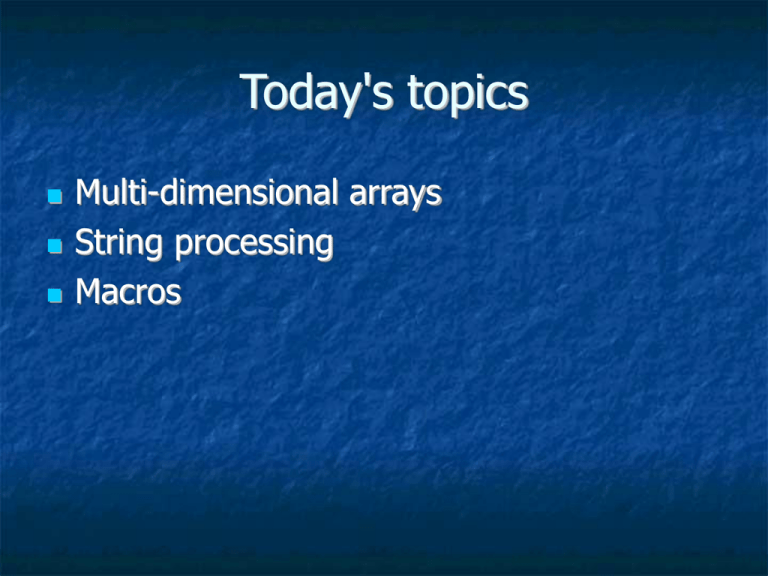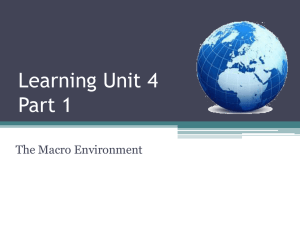Lecture #16
advertisement

Today's topics Multi-dimensional arrays String processing Macros 2-dimensional arrays Example declaration: Matrix DWORD Row major order Row index first (5 rows, 3 columns) i.e., 5 rows, 3 elements per row In HLLs, reference Matrix[0][2] 5 DUP(3 DUP(?)) ; 15 elements Last element in first row … etc. In assembly language, it’s just a set of contiguous memory locations 2-dimensional arrays An element’s address is calculated as the base address plus an offset BaseAddress + elementSize * [(row# * elementsPerRow) + column#] Example: Suppose Matrix is at address 20A0h 4*[(3*3)+1] = 4*[9+1] The address of Matrix[3][1] is = 4 * Ah 20A0h + 4 * [(3 * 3) + 1] = 20C8h = 28h Base address Size of DWORD Row index Elements per row Column index Matrix: element addresses (hexadecimal) Matrix 0 1 2 0 20A0 20A4 20A8 1 20AC 20B0 20B4 2 20B8 20BC 20C0 3 20C4 20C8 20CC 4 20D0 20D4 20D8 Local Directive A local variable is created, used, and destroyed within a single procedure The LOCAL directive declares a list of local variables immediately follows the PROC directive each variable is assigned a type Syntax: LOCAL varlist Example: MySub PROC LOCAL var1:BYTE, var2:WORD, var3:SDWORD Local variables MASM keeps local variables on the system stack Generates replacement code for the LOCAL directive Sort PROC LOCAL temp:DWORD, SwapFlag:BYTE ; procedure code ret Sort ENDP MASM generates the following code: Sort PROC push ebp mov ebp,esp sub esp,08h ;subtract 8 from ESP ; to create space for local variables ; procedure code pop ebp ret Sort ENDP LEA Instruction • • • • LEA means Load Effective Address Returns offsets of both direct and indirect operands. LEA is required when obtaining the offset of a local variable or stack parameter. Example: CopyString PROC LOCAL temp[20]:BYTE, count:DWORD mov mov lea lea edi,OFFSET esi,OFFSET edi,count esi,temp count; invalid operand temp ; invalid operand ; ok ; ok String primitives A string is an array of BYTE In most cases, an extra byte is needed for the zero-byte terminator MASM has some “string primitives” for manipulating strings byte-by-byte Most important are: lodsb stosb cld std ; ; ; ; load string byte store string byte clear direction flag set direction flag There are many others Explore on your own lodsb and stosb lodsb Moves byte at [esi] into the AL register Increments esi if direction flag is 0 Decrements esi if direction flag is 1 stosb Moves byte in the AL register to memory at [edi] Increments edi if direction flag is 0 Decrements edi if direction flag is 1 cld and std cld Sets direction flag to 0 Causes esi and edi to be incremented by lodsb and stosb Used for moving “forward” through an array std Sets direction flag to 1 Causes esi and edi to be decremented by lodsb and stosb Used for moving “backward” through an array Demo Program Linked to course website “Resources” page demo6.asm: Shows capitalizing and reversing a string Questions on … Arrays ? Parameter passing ? System stack ? Stack frame ? Local variables? Strings? Procedure (summary) Separate, named section of code. May have parameters Calling mechanism Return mechanism During assembly, procedure code is translated once. During execution, control is transferred to the procedure at each call (activation record, etc.). May be called many times. All labels, etc. are local to the activation record. Macro Separate, named section of code Once defined, it can be invoked (called) one or more times. May have parameters Use name only (don’t use CALL) During assembly, entire macro code is substituted for each call (expansion) Similar to a constant Invisible to the programmer Defining Macros A macro must be defined before it can be used. Parameters are optional. Each parameter follows the rules for identifiers. Syntax: macroname MACRO [parameter-1, parameter-2,...] statement-list ENDM Invoking Macros To invoke a macro, just give the name and the arguments (if any). Each argument matches a declared parameter. Each parameter is replaced by its corresponding argument when the macro is expanded. When a macro expands, it generates assembly language source code. Example macro definition and call Sets up registers and uses Irvine's library WriteString mWriteStr MACRO buffer push edx mov edx,OFFSET buffer call WriteString pop edx ENDM .data str1 BYTE "Welcome!",10,13,0 str2 BYTE "Please tell me your name ",0 .code . . . mWriteStr str1 mWriteStr str2 . . . Example macro expansion The expanded code shows how the str1 argument replaced the parameter named buffer: mWriteStr MACRO buffer push edx mov edx,OFFSET buffer call WriteString pop edx ENDM 1 1 1 1 push mov call pop edx edx,OFFSET str1 WriteString edx Example macro definition and call The mReadStr macro provides a convenient wrapper around ReadString procedure calls. mReadStr MACRO varName push ecx push edx mov edx,OFFSET varName mov ecx,(SIZEOF varName) – 1 ; Why? call ReadString pop edx pop ecx ENDM .data firstName BYTE 30 DUP(?) .code . . . mReadStr firstName . . . A more complex macro seq macro a, b mov eax,a mov ebx,b test: cmp eax,ebx jg quit call WriteDec inc eax jmp test quit: endm ; Print a sequence ; from a to b ; if a <= b ; print a and repeat ; otherwise quit What's the problem? Code is expanded for each call If the macro is called more than once . . . Duplicate labels Register conflicts Duplicate labels You can specify that a label is LOCAL MASM handles the problem by appending a unique number to the label Seq LOCAL mov mov test: cmp jg quit . . . macro a, b test ; Print a sequence eax,a ; from a to b ebx,b eax,ebx ; if a <= b Local variables in macros You can specify that a variable is LOCAL seq macro a, b ; Print a sequence LOCAL test ; from a to b LOCAL sum .data ;; data segment sum DWORD ? ;; define local var .code ;; code segment mov eax,a mov ebx,b test: cmp eax,ebx ; if a <= b jg quit . . . Parameters Arguments are substituted exactly as entered, so any valid argument can be used. Example calls to seq : seq seq seq x,y ecx,edx 1,20 ;memory ;registers ;literals Macro vs. Procedure Macros are very convenient, easy to understand Macros actually execute faster than procedures Macros are invoked by name No return address, stack manipulation, etc. Parameters are “in-line” Macro does not have a ret statement (Why?) Why would you ever use a procedure instead of a macro? If the macro is called many times, the assembler produces “fat code” Invisible to the programmer Each macro call expands the program code by the length of the macro code Macro vs. Procedure Use a macro for short code that is called “a few” times. Use a procedure for more complex tasks or code that is called “many” times The terms “few” and “many” are relative to the size of the whole program Is it OK to invoke a macro inside of a loop that executes 1000 times ? Is it OK to invoke a procedure inside of a loop that executes 1000 times ? Demo Program Linked to course website “Resources” page demo7.asm: shows macros, macro calls, and macro parameters Questions? If learning assembly language does nothing else for you, it makes you appreciate high-level languages.









